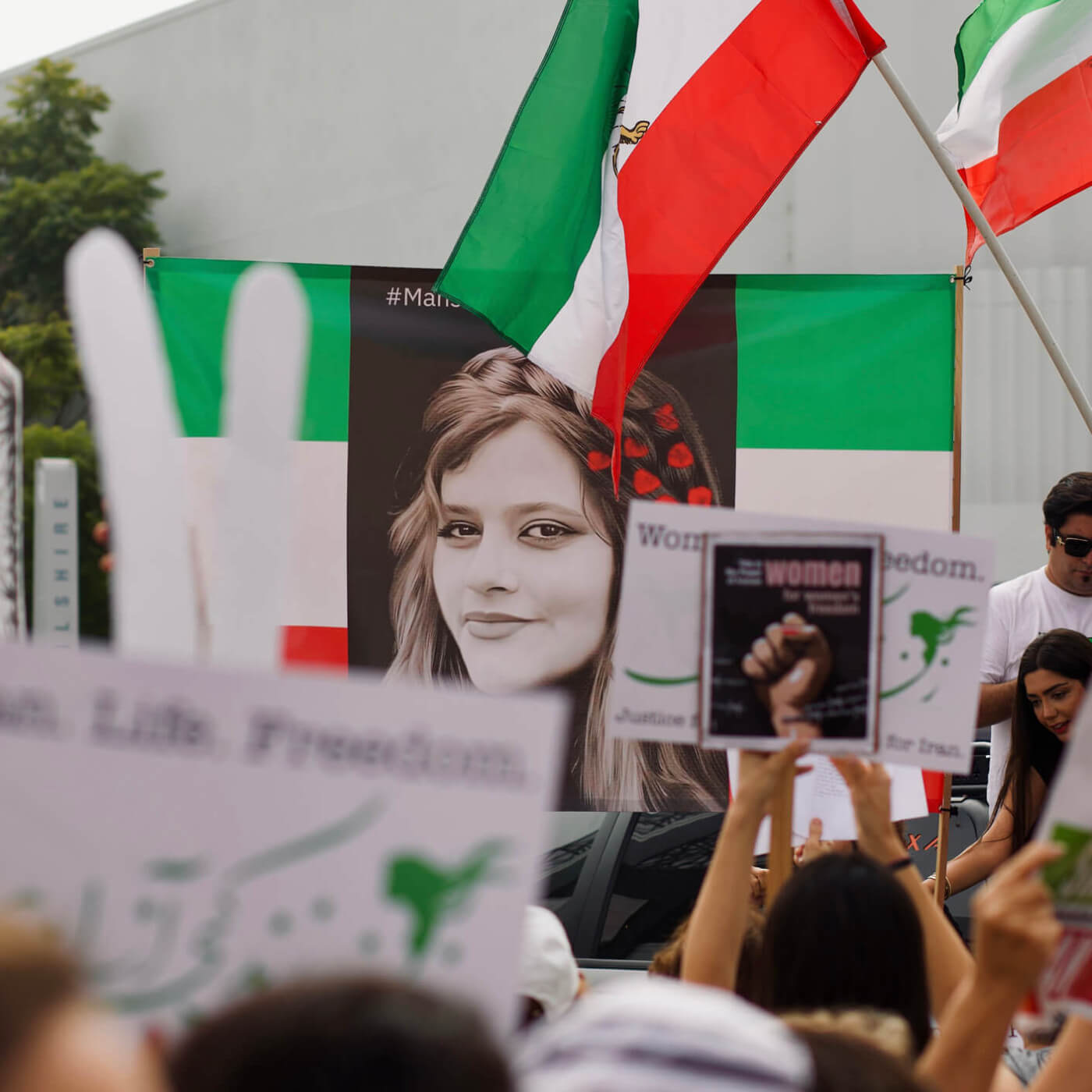Written by Bennett Kirschner
Over the past month, we’ve had no shortage of updates from the mainstream media about the Russian invasion of Ukraine, or the upcoming elections that will determine the balance of power in the US. While both stories definitely carry a great deal of urgency, an equally important one – the series of uprisings across Iran that pose a very real threat to the national government – has received relatively scant coverage. The occasional mentions of the “protests” since they began last month fail to reflect how dramatically the Iranian opposition movement has evolved: it has far more political traction than any protest that preceded it, including the country’s presidential election protests in 2009, its general strikes in 2018, and its fuel price protests in 2019. Chants of “don’t call it protests, call it a revolution” come from a people that continue to seek recognition from their own authoritarian government and an international community that sits idly by.
Since the Revolution of 1979 put the current Islamic Republic in power, several restrictions have relegated Iranian women to a position of subservience: women can’t sing or play music in public; they are forbidden from attending public sporting events; and they can be married off by their fathers as soon as they turn twelve years old. Yet perhaps the most pervasive restriction is the requirement that all women cover their hair with hijabs whenever they are in public or “communal spaces” such as college dormitories. Since 1981, this law has been enforced by Iran’s Guidance Patrol, more commonly known as the “morality police”: a state-sanctioned law enforcement agency that’s primarily responsible for punishing violators of this particular law. Though the current uprising has blossomed into something much more, the spark that ignited this fire was this hijab requirement and the tragic death of a young woman at the hands of the morality police. Another slogan of the revolution – “Woman, Life, Liberty” – captures this trajectory, from a string of protests for women’s rights to the most formidable opposition movement in Iran since 1979.
Mahsa Amini, a 22-year-old Iranian woman who went by her Kurdish name, Jhina, had come to Tehran for a brief family visit in mid-September. She had recently been admitted to a University and was shopping with family members on September 13th when the morality police arrested her for wearing “tight trousers,”and her hijab “too loosely.” According to several eyewitness accounts that were relayed to Amini’s family, she was then violently beaten both in the police van and at the police station, where she slipped into a coma. Less than 72 hours later, she died in the hospital from what was undoubtedly head trauma, though Iranian authorities continue to insist it was the result of a mysterious and altogether unprecedented “heart attack.” Medical records obtained by a London-based news outlet corroborate that Amini had, in fact, suffered a skull fracture and cerebral hemorrhage, almost certainly incurred through blunt force, and that she showed no signs of cardiac arrest.
Striking several chords that were already at the forefront of the national political consciousness, news of Jhina’s death spread quickly across Iran. After all, she embodied so much of what was wrong throughout the country: she was a young, unassuming woman who had a promising future and no prior history in political advocacy, murdered for simply wearing her clothes as she wished. She was also a member of Iran’s Kurdish minority, which remains disenfranchised by a Persian government that has prioritized its own culture over other ethnicities’ since claiming power in 1979.
Yet Jhina’s identity wasn’t the only factor that tipped the scales – just one month before her death, Iran’s newly anointed President, Ebrahim Raisi, had announced the use of facial recognition on public transportation to identify women who did not properly don their headscarves, along with mandatory prison sentences for any Iranian citizen who openly questioned the government’s hijab policy. A severe disconnect between the government’s priorities and the beliefs of its people was becoming more clear than ever: the Iranian people were overwhelmingly opposed to hijab laws. While polls show at least 72% of Iranians think that women should have the right to not wear a hijab, the government has only imposed more stringent laws and brutal punishments since Raisi’s inauguration in 2021.
Within days of Jhina’s death protests were erupting across the country, from her native province of Kurdistan to the streets of Tehran, where she was originally detained. Images of women tearing off and burning their headscarves, along with crowds of schoolgirls taking off their hijabs while yelling “Death to the Dictator!” encapsulated a movement focused on the long-overdue liberation of Iranian women. However, over the ensuing weeks the protests have grown in scope to reflect so many of the issues plaguing the Iranian people: poor living conditions, religious fundamentalism, and political repression have all become vital touchpoints for a movement that spans several generations and ethnicities.
Each of these concerns has only been fueled by the government’s brutal response to the protests. The indiscriminate spraying of tear gas and firing of live rounds into crowds of peaceful protesters, including groups of college students, have only proven the revolution’s point – Iran is led by a fundamentalist, authoritarian regime that is interested in little else beyond its own retention of power. The police response has already killed at least 244 protesters, including 16-year-old women such as Nika Shakarami and Sarina Esmaildzadeh, who have joined Amini as posthumous revolutionary icons. Law enforcement has also detained over 12,500 protesters across the country, many of whom are missing to this day. Meanwhile, government representatives spread false rumors that the deaths of both Shakarami and Esmaeldsadeh were “suicides,” and that the protests are the direct result of a Western conspiracy intended to tear the country apart.
It should come as no surprise that the Iranian government is able to push these false narratives thanks to crackdowns on journalism and internet accessibility across the country. This is also perhaps the main reason we’ve heard so little about the ongoing rebellion. Countless journalists, both domestic and foreign, have been detained or disappeared during the protests, which has led to a mass exodus of foreign journalists who fear the same fate. Similarly, rolling internet shutdowns have stripped both the outside world and Iranians of any opportunity to follow what is happening in Iran. Social media platforms such as WhatsApp, Instagram, Skype, and LinkedIn are blocked throughout the country, along with a litany of apps that would give Iranians access to a connected internet. While some guerrilla outlets such as the 1500tasvir Instagram page manage to disseminate documentation of the rebellion and the brutal government response, scant information exists in regards to the ongoing state of the revolution.
Somehow, there is still a glimmer of hope amidst all of this: the uprising has spread to crucial domestic markets, including the oil industry and bazaars, where thousands of workers are on general strike until the Iranian government meets the protests’ demands. Such acts of solidarity demonstrate that the uprising has gained cultural and economic traction, and that brushing the whole movement aside won’t be as straightforward as it has been in the past for the Islamic Republic. Yet for many protesters, the time for reform has come and gone – having repeatedly responded to public dissent with the same systemic, deadly violence over the past two decades, the government has proven itself incapable of negotiation or reform. It must be dissolved and replaced with a more sound, conscientious government.
How can someone living in the United States help support the revolution from so far away? In this article from Truthout, various Iranians speak out about the flawed perception that the Iranian populace needs a direct intervention from a foreign power to support their needs. The article, however, does miss a key point when it claims that lifting the United States’ ongoing sanctions against Iran would help lift working class Iranians from the squalid conditions they’re facing. In fact, the opposite is true – choosing to resume trade with Iran in any capacity, including a nuclear deal, would only put more resources in the hands of the same regime that is apprehending and killing its own citizens. The Iranian people would not see a penny of those lifted sanctions, other than in the form of the barrel of the gun pointed directly at them.
Instead of lifting sanctions and providing more leverage to the oppressors, world leaders must further sanction all members of the Islamic regime in order to limit its resources. The US Secretary of State has already taken steps towards this end, but more can always be done. Iranians deserve to live with a sense of dignity and freedom – it is our responsibility, then, to shed as much light as we can on the nation’s current circumstance as it continues to unfold, and to demand that our government officials do whatever they can to isolate the Iranian regime. Though it may be hard to tell, the world is still watching.
SIGN: This “A Free Iran” letter to President Biden, which makes specific demands that could help liberate the Iranian people.


















